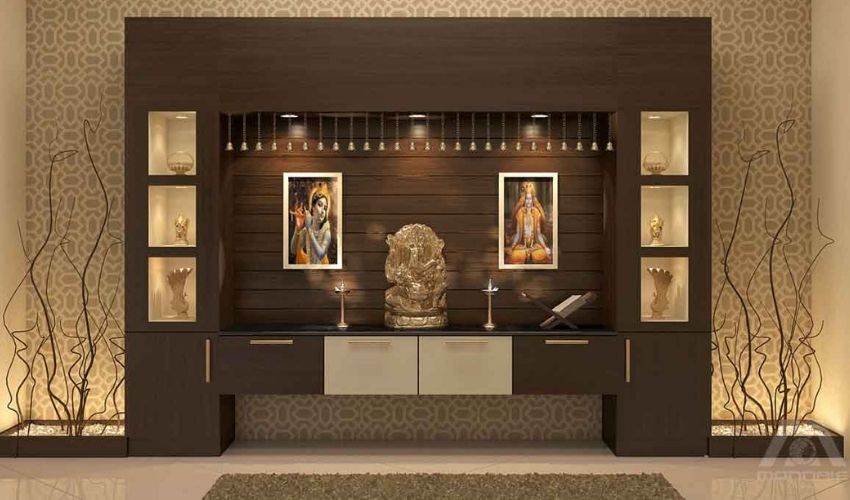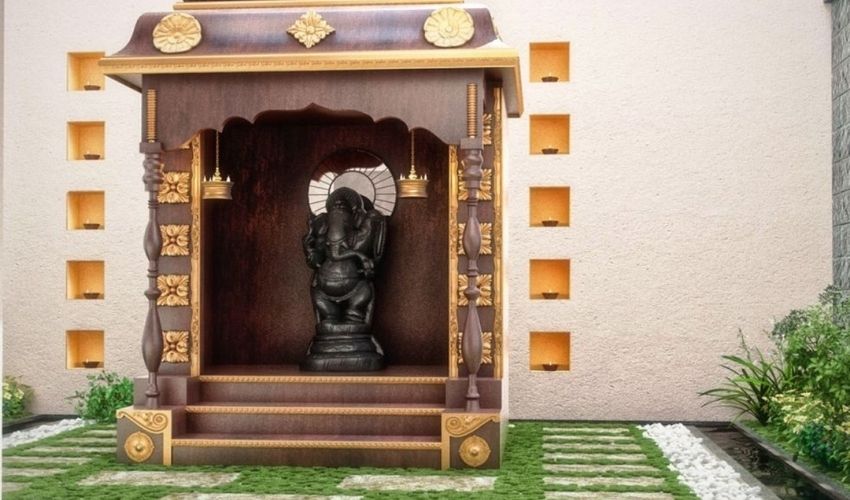For centuries, Pooja Rooms have had significance in many cultural and spiritual traditions because they give people and families a unique place to practice their religion and engage in rituals.
Nowadays, in this materialistic world, everyone has a hectic schedule, so they cannot find solace. Consequently, it is leading to more stress and anxiety for individuals. And here, the pooja room comes to the rescue! As it harmonizes their emotions. Apart from this, it also assists them in realigning with their ancestors, culture, and traditions.
It is essential to have a pooja room at home as one can pay homage to God. Additionally, on special occasions, family members get together, breaking their busy schedules, which has a profound impact on their mental and physical being and significantly deepens family bonding.
With the advancement in various fields, ample choices are available, and the same goes for the architecture of pooja rooms. There are several types of pooja room designs and our interior designers in hyderabad listed them below.
Traditional pooja room design:

Traditional pooja room designs like elaborate woodwork, detailed carvings, and religious symbols are incorporated. Traditional Pooja Rooms frequently have a sense of beauty, fine craftsmanship, and vibrant colors.
Modern Minimalist Designed Pooja Room:
Modern-designed Pooja room are where the emphasis is on clarity and simplicity. It could include minimalistic shelving for alcoves with a subtle color scheme and modern materials like glass, metal, or marble.

Mandir Pooja Room design:
Mandir design in which historical religious temples play a crucial role as it imitates domes or arches and sometimes pillars which are usually found in temples.
Wall-mounted Pooja Room design:

A wall-mounted design is a space-saving option for families with limited space. It could have a small cabinet or shelf put on the wall to serve as a designated area for spiritual practices without taking up a lot of space.
Open-Shelf Pooja Room Design:
The Open-Shelf design is built-in open niches or shelves where religious artifacts and idols can be placed. It provides simple accessibility and enables decor modification.
Cabinet Pooja Room design:
cabinet design, which is easily opened or closed, is self-contained modules. When they are shut, they resemble a typical cabinet or closet and offer a covert place to keep religious objects. They open to expose a gorgeously decorated Pooja area.
Contemporary Fusion design:

The Contemporary Fusion design combines classic and modern design aspects. It could blend conventional symbols or artifacts with a modern, streamlined environment to provide a distinctive, unique appearance.
Room within a Pooja Design:
Room within a room design in which a separate room for pooja room is created within homes. Also, the best part is that it allows the pooja room to be decorated in many ways, be it with frescoes, stained glass windows, or detailed ceiling designs.
Outdoor pooja space:

Outdoor pooja space where pooja rooms are built in the open. This location frequently includes a modest shrine, chairs, and natural features that increase the sense of association with the environment and spiritualism.
Apart from it, there are a variety of door designs and factors, especially for pooja rooms, as it plays a significant role in creating a pooja space, a sacred one.
And Also Read About:
TRENDING POOJA MANDIR DESIGNS FOR YOUR HOME
Door Designs for Pooja Room:
Wooden Doors:
These types of doors are Wooden and preferred by those who love historical motifs and arts as these are beautifully carved. Therefore, giving it an aesthetic appearance.
Glass Doors:

These types of doors are fully made up of transparent glass and give a modern look. Also, these doors have distinct patterns be it Sanskrit verses, religious symbols, or intricate patterns.
Metallic Doors:
These types of doors are either made up of metal or bronze and engraved with traditional auspicious symbols, bells, and sometimes with deities. All this resonates with traditional aesthetics and gives charm, which is long-lasting.
Sliding Doors:
These types of doors are quite common these days as it saves space and can be customized according to one’s preference.
Mandir-style Doors:
These doors are made after getting inspired by Temple architecture and imitate look like a temple with pillars and arches. By choosing this type of door, the individuals get the spirit of a temple at home.
Modern Minimalist Doors:

These doors might be an excellent choice for individuals who want a neat, uncluttered appearance. It emphasizes simplicity and frequently has smooth lines, delicate textures, and understated carvings that create a calming atmosphere.
Don’t bother if one doesn’t have enough space for a pooja room at their home.In this contemporary world, we have numerous alternatives that give the same charm with limited area.
And Also Read About:
Stunning Pooja Room Door Designs
INSPIRING AND GORGEOUS POOJA ROOM DOOR DESIGNS FOR YOUR HOME
Nook or small corner:
A nook or small corner might be appropriate to use as a Pooja place. This can be done by installing a wall-mounted shelf or a small Pooja unit that holds the most important religious objects, idols, and holy books.
Floating shelves:
Another option could be to introduce floating shelves to exhibit religious objects, candles, or incense, you can make the most of the vertical space available.
Portable Pooja setups:
Portable Pooja setups that can be set up for a moment and then put away when not in use, like foldable altars or travel-sized Pooja kits. To make it more appealing, one can create rangoli at the front and paste religious symbols, which are easily available in the market.
Well, even if adjusted with space, some people are confused about which design to go for.
In my opinion, it totally depends on the individual if he or she wants to go for, whether traditional or modern. And all this depends upon their religious beliefs.
Choosing wooden, metal, or marble styles represents durability. Opting for sacred symbols and verses gives a sense of a devotional environment. Lights and simple décor give a glimpse of a calm and peaceful atmosphere. Ideas that involve working with eco-friendly materials, using LED lighting for a calm glow, incorporating simple layouts with hidden storage, and choosing wall-mounted shrines or movable elements that preserve the area are examples of the latest pooja room designs while maintaining a religious environment as told by our interior designers in chennai.
Budget-Friendly Pooja Room Designs Tips
Achieving an attractive pooja room on a budget can be possible with some simplest tips: you can have low cost pooja room design by using materials that require less cost like: stay on budget by choosing cheap and durable materials like wood or quality marble tiles; go for minimalist approach, add in some do-it-yourself elements and look at modular designs as well since they tend to be more flexible and cheaper.
Wrapping up:
The Pooja room plays a significant role in the lives of the individuals as it acts as a small shrine inside a person's house. Having a designated place of worship allows those who might not have the chance to go to distant religious places to have a feeling of dedication and connection. No matter whether the room is small or big, constructing a Pooja room in a limited space where spiritual comfort may occur serves as a reminder that even the smallest spaces in our homes can be turned into unique places for prayer. These pooja room design ideas from our interior designers in hyderabad will help you to get a divine pooja unit that grace your home.
Reach out to our design experts for customized pooja units and home interiors now!
FAQs
- Where should I place my pooja room?
According to the principles of Vaastu, place your Pooja room in a serene and quiet section of your house, ideally facing east or northeast, to draw in uplifting energy and spiritual tranquillity.
2. How to design a pooja room?
Designing your Pooja room with a fusion of ancient and contemporary aesthetics, sacred symbols, idols, and calming colours is important. You should also ensure there is enough storage for religious artifacts and that the space has a calm atmosphere conducive to meditation and devotion.
3. What is the minimum space of a pooja room?
A Pooja room should have a minimum size of 2.5 feet by 2.5 feet to allow for the storage of necessary religious artifacts and to create a calm atmosphere for praying and doing meditation.
And Also Read: Modern Home Temple Design Ideas




.png)

.png)



 2026 | All Rights Reserved
2026 | All Rights Reserved